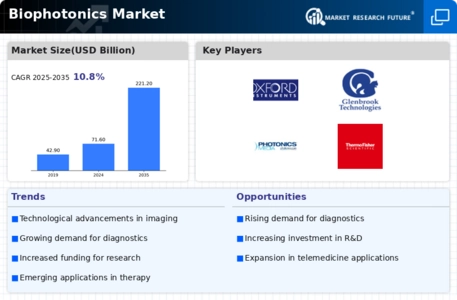Leading market players are investing heavily in research and development in order to expand their product lines, which will help the market of biophotonics, grow even more. Market participants are also undertaking a variety of strategic activities to expand their global footprint, with important market developments including new product launches, contractual agreements, mergers and acquisitions, higher investments, and collaboration with other organizations. To expand and survive in a more competitive and rising market climate, Biophotonics industry must offer cost-effective items.
Manufacturing locally to minimize operational costs is one of the key business tactics used by manufacturers in the global Biophotonics industry to benefit clients and increase the market sector. In recent years, the Biophotonics industry has offered some of the most significant advantages to medicine. Major players in the market of biophotonics, including Oxford Instruments, Olympus Corporation, Lumenis Be Ltd., IDEX, Zenalux Biomedical, Inc., Glenbrook Technologies, Photonics Media, and Thermo Fisher Scientific Inc.
Manufacturer of optical and digital precision equipment and tools is Olympus Corp (Olympus). The business creates, produces, and sells tools and gadgets for the medical, healthcare, imaging, information, and other commercial areas. It provides scientific solutions like laser scanning microscopes, industrial and biological microscope systems, remote visual inspection products, and non-destructive testing systems, as well as medical systems like endotherapy devices, endoscopes, and endoscopy products to assist healthcare professionals in treating patients. Additionally, it provides services for system development and biological materials. The business has operations in the Americas, Europe, and Asia-Pacific through its subsidiaries and facilities.
Japan's Tokyo is home to Olympus Corp. Olympus U.S.A debuted their most recent endobronchial ultrasound (EBU.S.) technology for the needle biopsy diagnosis and staging of lung cancer on May 12, 2021. The FDA 510(k) has approved the recently introduced BF-UC190F EBU.S. bronchoscope, making it the newest member of Olympus America's EBU.S. range.
The optical and opto-electronic sector is dominated by the Carl Zeiss AG group of businesses, which operates globally. The three futuristic markets of industrial solutions, lifestyle products, and medical and research solutions are where the five separately running company groupings are active. The corporation has its headquarters in Oberkochen, Germany, and was established in Jena in 1846. For more than 160 years, the firm has been a technological leader in optical innovation. The Carl Zeiss Stiftung owns the entirety of Carl Zeiss AG (Carl Zeiss Foundation). Almost 13,000 people work for Carl Zeiss worldwide, including more than 8,000 in Germany.
With an expenditure of USD 180 million, Zeiss opened a new research and development, production, sales, and customer support facility in the U.S. in March 2021, expanding its footprint in North America. The X-ray Microscopy business and the ZEISS Microscopy Customer Center will both be included on the new site to serve the prospects in materials research, life sciences, and industrial applications.















